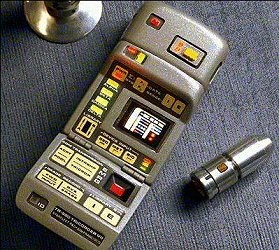Since its beginning in 1966, Star Trek has captured its audience for generations. Starting with The Original Series in 1966, many new series and movies have debuted. For Television shows following the original series there was the Animated Series, The Next Generation, Deep Space Nine, Voyager, and Enterprise.
“Dammit Jim, I’m a doctor, not a miracle worker.” Thanks to Leonard “Bones” McCoy, this phrase is well known in the world of Star Trek. From the first episode it was used, it has sparked many different spin offs in The Original Series.
“Dammit Jim, I’m a doctor, not a miracle worker.” Thanks to Leonard “Bones” McCoy, this phrase is well known in the world of Star Trek. From the first episode it was used, it has sparked many different spin offs in The Original Series.
Taking place in the mid-23rd century, the show was depicted with many new technologies and sciences. Warp Drives, Faster Than Light travel from said Warp Drives, but the thing that I will be focusing on in this post is the medical advancements. One of the most iconic technologies of the Star Trek universe would have to be the Tricorder.
The tricorder did everything. It was used for data sensing, recording information, analyzing data, and many other functions. There were also many different tricorders. The different tricorders had many different functions from the original functions, to being able to sense medical problems. These medical tricorders worked hand in hand with the portable, handheld scanner. These medical tricorders were primarily used out in the field or on the ship to do a primary assessment of a patient
“While the suite of sensors installed on medical tricorders is advanced, it is generally no substitute for the advanced and specialized equipment in a sickbay facility.” – Memory Alpha
Since the first appearance of the tricorder in the mid-60s, scientist and medical professionals have been trying to make their machines and instruments more portable. At the time the space race was in high gear. Because of this, medical professionals were trying to find ways to be able to send medical equipment with the astronauts when they went into space. Another way the science fiction of the day was coming to life was the technological advancements of medical records and hospital care.
According to Kate Lunau, there is a competition in progress of developing a real life tricorder. The competition named, The Qualcomm Tricorder X Prize, has only a few specific guidelines;
According to Kate Lunau, there is a competition in progress of developing a real life tricorder. The competition named, The Qualcomm Tricorder X Prize, has only a few specific guidelines;
“As envisioned for this competition, the device will be a tool capable of capturing key health metrics and diagnosing a set of 15 diseases. Metrics for health could include such elements as blood pressure, respiratory rate, and temperature. Ultimately, this tool will collect large volumes of data from ongoing measurement of health states through a combination of wireless sensors, imaging technologies, and portable, non-invasive laboratory replacements. … the device's physical appearance and functionality may vary immensely from team to team. Indeed, the only stated limit on form is that the mass of its components together must be no greater than five pounds.”
The competition began in 2010, and the final judging isn’t expected to be until 2014 if not even 2015. The grand prize is $10,000,000. If you have personal knowledge of medical technology, you really should give it a thought to enter the competition! Here is the link to the website of the competition.
A previous competition much like this one was the competition to create a private spacecraft. The winner of this was SpaceShipOne, now part of Virgin Galactic.
Another technology from the series that is now being made into a real technology is Geordi LaForges’s visor. According to the series, LaForge was born blind, but was given the chance to see when he turned five. He was given a visor that gave him the ability to see.
This science behind science fiction is becoming reality. An implant created by a German Scientist is now giving people with retinitis pigmentosa the ability to see. This light sensitive implant is attached to the retina and sends electrical signals to the brain. (1) Essentially, it is a replacement retina. Another product that is helping the blind regain sight is Argus II Retinal Prosthesis System. This is much more like Geordi’s Visor. Created by Second Sight Medical Products, the Argus II Retinal Prosthesis System, the product consists of glasses with cameras on the front connected to 60 electrodes that have been implanted on the retina. Both of these bypass the problem with the retina so that people are able to see. (2)
Even further in the future, medical technologies like the ones from Star Trek will be readily available for doctors and physicians of the day.
A previous competition much like this one was the competition to create a private spacecraft. The winner of this was SpaceShipOne, now part of Virgin Galactic.
Another technology from the series that is now being made into a real technology is Geordi LaForges’s visor. According to the series, LaForge was born blind, but was given the chance to see when he turned five. He was given a visor that gave him the ability to see.
This science behind science fiction is becoming reality. An implant created by a German Scientist is now giving people with retinitis pigmentosa the ability to see. This light sensitive implant is attached to the retina and sends electrical signals to the brain. (1) Essentially, it is a replacement retina. Another product that is helping the blind regain sight is Argus II Retinal Prosthesis System. This is much more like Geordi’s Visor. Created by Second Sight Medical Products, the Argus II Retinal Prosthesis System, the product consists of glasses with cameras on the front connected to 60 electrodes that have been implanted on the retina. Both of these bypass the problem with the retina so that people are able to see. (2)
Even further in the future, medical technologies like the ones from Star Trek will be readily available for doctors and physicians of the day.


 RSS Feed
RSS Feed